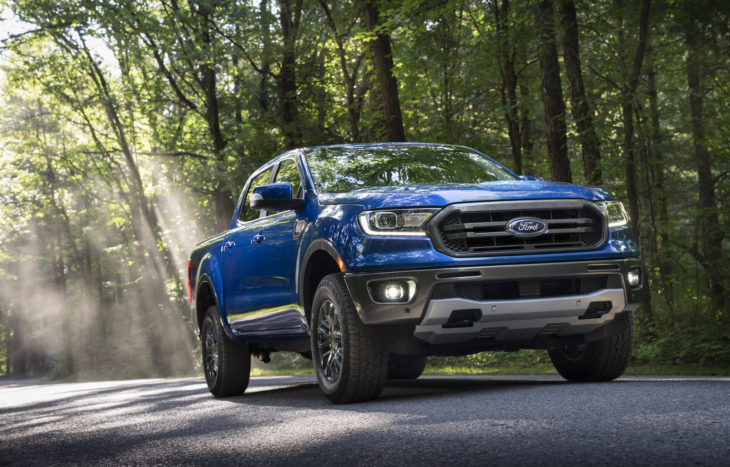By Andrew Halonen, Mayflower Consulting LLC.
When consumers think about the material makeup of an automobile, they mostly think about the plastics and cloth in the interior, glass in the windows, cast metal in the engine, and the metal sheet in the exterior body, doors, and hood. Not much conversation focuses on the parts not visible from the outside, in particular the suspension components hidden behind the wheels. Mayflower Consulting conducted a recent study that examines the form and function of suspension components and their value to the light metal industry. It also looked at the impact of suspension materials as OEMs shift their vehicles powertrains from the internal combustion engine to a mix of electrified products. By exploring this area of the vehicle and providing new information, the study aims to create meaningful business opportunities for aluminum.
Suspension Systems
The suspension system is comprised of the knuckle that is mounted to the wheel, the links or arms that connect the wheel to the body, and bars to maintain stability. The knuckle provides a strong connection to support the brake caliper, the bearing, and the shocks and arms. The arms are key to providing relief from bumps and vibrations from the road, along with stability when cornering and braking. When the vehicle is in a crash, it is imperative that these parts bend before they break, a key characteristic that drives stringent material properties. In some instances, suspension components are counted on to absorb crash energy to protect the passenger compartment. All of this relates to safe driving, reliable performance, and passenger comfort.
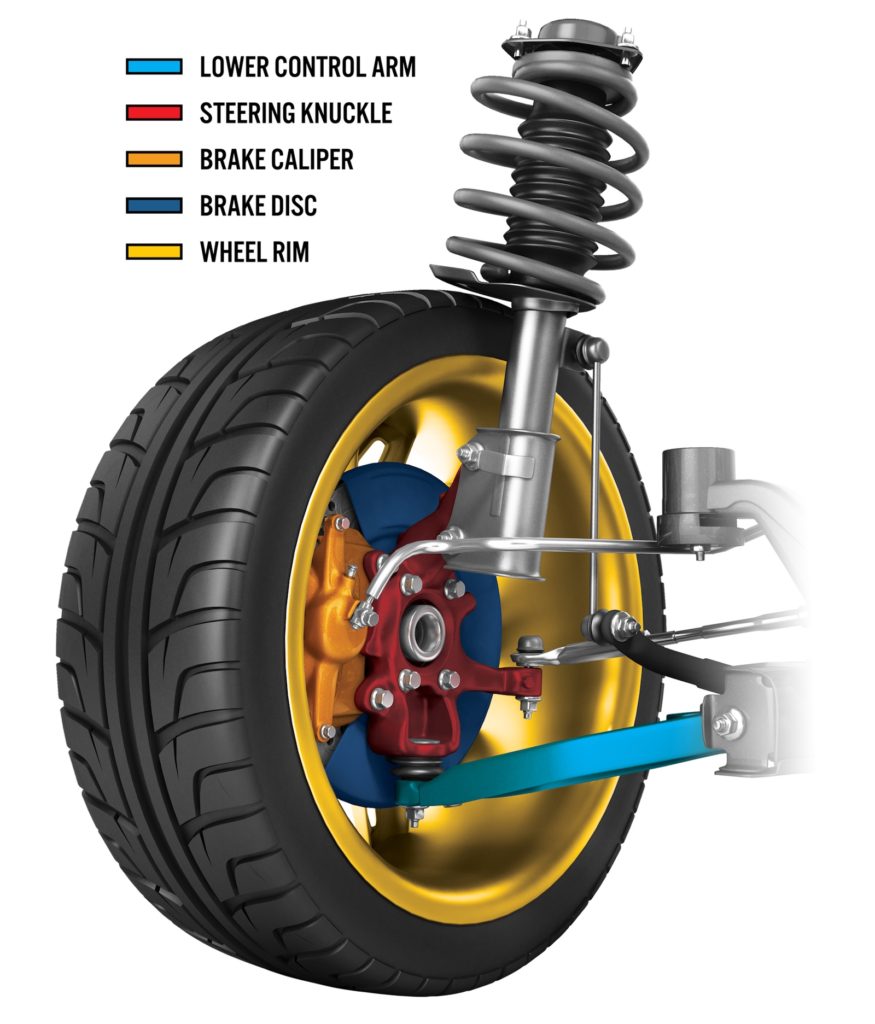
A number of types of suspension systems are available, each differing based on a number of parameters, including the size of the vehicle, whether the system is located in the front and rear of the vehicle, the number and type of components, and the types of materials. For vehicles under 4,000 lbs (1,814 kg), the front suspension is called a MacPherson strut, which includes a steering knuckle, a lower control arm, and a shock (a strut) mounted to the top of the knuckle (Figure 1).
For larger and heavier vehicles (as well as luxury models), the MacPherson strut is replaced by a double wishbone suspension that has a knuckle and lower control arm in addition to an upper control arm. The double wishbone provides independent suspension, which provides better handling and comfort and makes it more responsive to heavy loads and tight cornering while driving. Rather than having a strut mounted to the top of the knuckle (as shown in Figure 1), there is an upper control arm with a ball joint connection at the top of the knuckle. The suspension system in the rear is generally similar, although there may be more links.
Suspension Materials Study
In 2017, Mayflower Consulting was active in the research discovery of applications that could benefit from a new and stronger aluminum alloy for foundry applications. At the time, the company had ten years of experience working with OEMs to replace gray iron brakes with aluminum metal matrix composites (MMC). The key benefits and attributes of the MMC brakes were that they were rust free, provided a 50% weight reduction, and would always run cool.
Combining this work with projects being done in lightweighting, Mayflower wondered what kinds of lightweight component choices auto manufacturers were making regarding suspensions. To find out, we visited auto dealerships with a camera and magnet and studied 89 different vehicles. During the course of this study, we learned a whole lot about the realities of these components. Due to our bias towards foundry and aluminum, we assumed most of the components would be comprised of shape cast aluminum. Instead, we found that nine different methods utilizing various materials were used to produce lower control arms on light duty vehicles in the U.S.
Over the past year, we decided to return to this 2017 analysis and conducted a new Automotive Suspension Study.1 OEMs typically benchmark three to five comparable vehicles in a segment. In comparison, the new study focused on 94 popular vehicles across 20 brands, including 65 crossovers and SUVs, 19 pickups and vans, and 8 electric vehicles (EVs). This provides a much richer data set to analyze, providing a deeper understanding of the decisions made by OEMs and why they make them. This information could then be provided to other OEMs, Tier 1 suppliers, and material manufacturers, enabling them to make more informed business decisions.
Aluminum Forgings
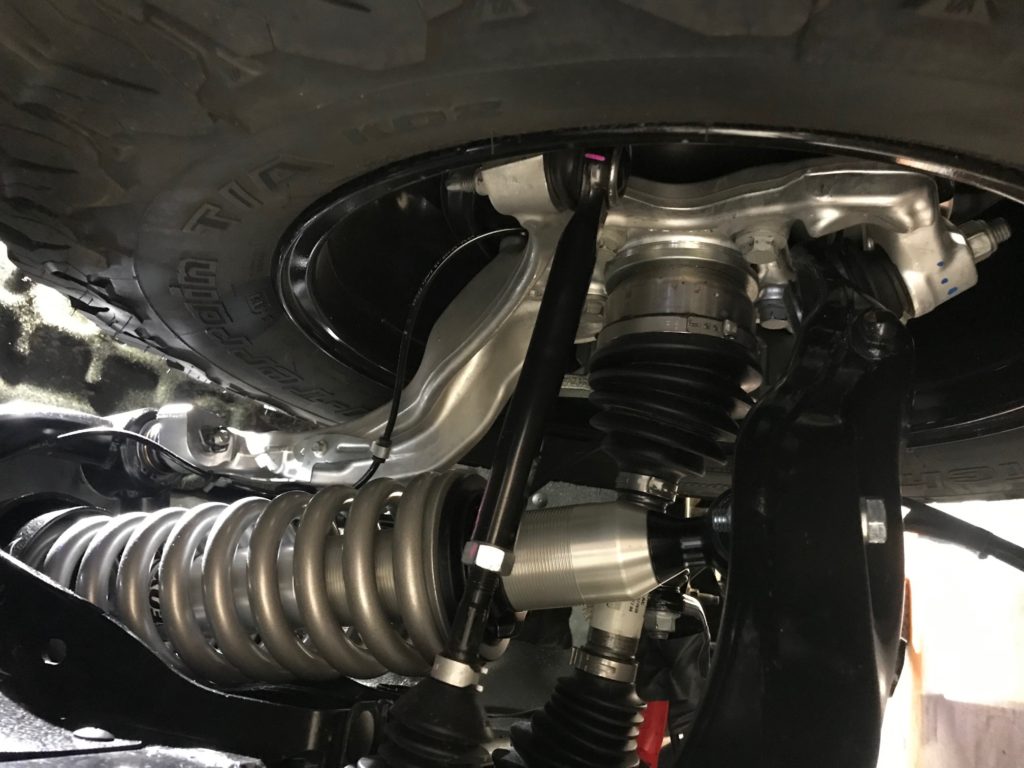
One of the areas of focus in the Automotive Suspension Study was aluminum forgings. We looked at the data to understand where aluminum forgings are used, what are the competing materials and forms, and their market potential. One prominent application of aluminum forgings was found in the front steering knuckle of the 2020 Ford Ranger (Figure 2).
The knuckle is a safety critical component that brings stability to the front wheel, so the property requirements are a combination of stiffness, strength, and elongation. Typical elongation is 10%, though more is preferred. Knuckles can be found in both the front and the rear of the vehicle. In the study, front knuckles were found to be made of forged aluminum, cast aluminum, and ductile iron. Rear knuckles were made of cast aluminum, ductile iron, and welded steel. Based on our analysis, we believe that the reason why forged aluminum was not found in rear knuckles was not due to any limitations in performance. Rather, it is likely because OEMs can meet lightweighting targets just as easily with lower cost aluminum castings.
Another component that is very popular in both the vehicle’s front and rear and on all independent suspensions is the lower control arm. These can be found in one-piece or, for lower weight yet with more connectors, in two-piece configurations. The lower control arm carries significant mechanical and fatigue loads. In an SUV or truck capable of rock crawling, the lower control arm will be subject to impact loads, too. In the study, we found five methods to produce front lower control arms, including forged aluminum, cast aluminum, welded steel, stamped steel, and ductile iron. A comparison of lower control arms can be found in Figure 3. As the image illustrates, the aluminum forging and welded steel are close in size. We have been told these two components are also close in weight, although the welded steel version is as much as three times lower in cost. The cast aluminum lower control arm is found on a vehicle comparable to that of the welded steel arm. However, because it carries a spring load in the arm, it is considerably larger and is twice the weight as the steel arm.
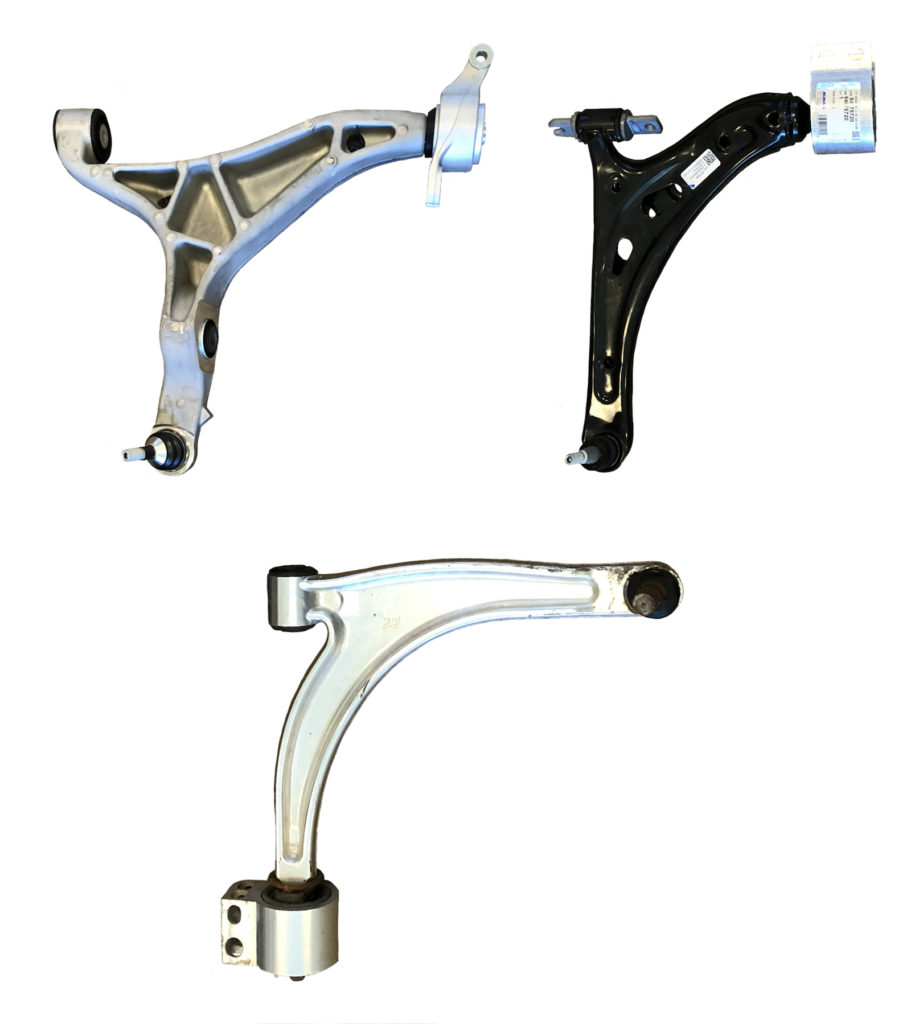
The EV Shift
As OEMs transition their powertrains from internal combustion models to those with battery packs, the weight distribution in the vehicle shifts, too. In most internal combustion vehicles today, the engine is located in the front with the transmission mounted to it. Both are heavy, which in turn means the center of gravity is located front of center. For this reason, when you apply the brakes, most of the braking power is located in the front too, which is why front brake discs are often thicker, larger, and heavier than those in the rear.
By comparison, a common EV, such as the Tesla Model 3, has no engine. Rather, the battery pack is located directly under the passenger compartment. The battery pack is estimated to weigh around 1,054 lbs (480 kg),2 making the braking energy balance closer to 50-50 (meaning it is the same in the front and rear). With this weight balance and the very high performance of an EV, the Tesla Model 3 requires thicker, larger, and heavier brake discs on both the front and rear. To support heavier brake discs and higher braking loads, the vehicle also needs larger knuckles and control arms. Therefore, not only are EVs carrying heavy batteries, but the brakes and suspension systems are heavier, too. The study found that, in order to compensate for the additional weight caused by the change in powertrain, EVs need to use significantly different suspension and brake caliper materials than the internal combustion engine vehicles.
The new study went a step further and analyzed two different vehicle chassis weights in order to consider the new skateboard battery/chassis concept used by many EVs in comparison to more common suspensions found in different body configurations. One analysis averaged the eight EVs in the study, while the second compared the Big Three pickup manufacturers against the proposed Rivian electric truck. In both cases, the materials were again found to differ significantly.
Opportunity for Aluminum Forgings
The Mayflower Consulting Automotive Suspension Study includes just over 750 different components, of which 30% were aluminum, 35% ductile iron, and 35% steel. Compared to the 49 in the 2017 study, the new suspension study showed a 4% gain in aluminum usage. Growth in aluminum forgings was found to be due to the replacement of suspension components made from either aluminum castings or ferrous material designs. We believe that further growth of aluminum forging as a replacement for these components remains a viable option. The replacement of cast aluminum would likely be done in order to improve toughness, especially in front knuckles and in the front lower control arms. On the other hand, aluminum forgings could replace ductile iron knuckles largely due to weight reduction. However, the competition is becoming increasingly steep, as iron has higher modulus (stiffness) and newly developed iron alloys are stronger, allowing thinner walls, as well as providing a lower cost. Once the performance metrics are met, cost is king.
Based on the study, the likely candidates for the use of aluminum forgings are the upper control arm, lower control arm, and knuckle in front suspensions and the trailing arm, toe link, integral link, leading and regular upper control arm, leading and regular lower control arm, and knuckle in rear suspensions. All but three of these eleven components were found to have been produced from forged aluminum. The three without examples of aluminum forgings were in the rear, knuckles, trailing arms, and lower control arms.
Bringing this analysis into the context of manufacturing plant and sales revenue, the study considered the production volumes and mass of aluminum forged components in the Ford F-150 and Chevy Equinox (Table I). In these examples, the current Ford F-150 front knuckle was cast aluminum, while the Chevy Equinox front lower control arm was welded steel. The volumes in both components provide an attractive proposition for forged aluminum producers—or for any material manufacturer or Tier 1 supplier looking to grow their presence in the automotive market. Considering this represents only two component examples across the 94 vehicles in the study, the potential value for aluminum forging manufacturers is immense.
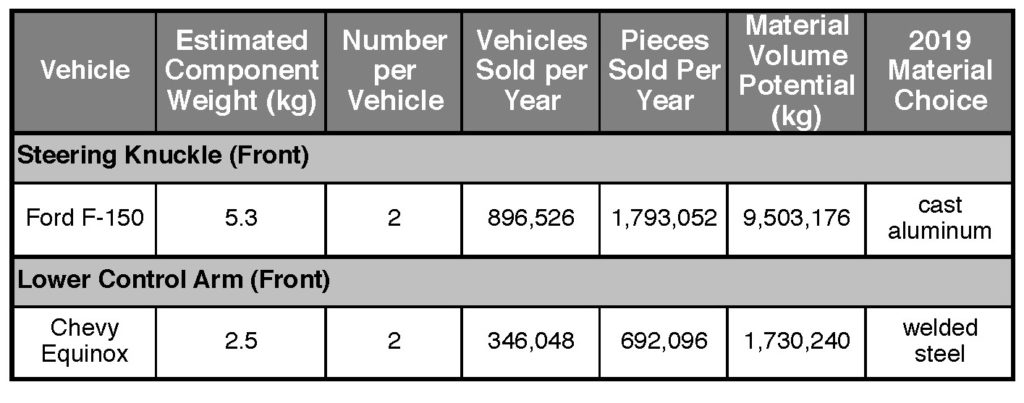
Understanding How OEM Decisions are Made
Now that the basic function of the suspension components, the common materials used, and the giant potential in sales volumes are understood, we need to consider how to find the target applications for new material and process technologies, like aluminum forging. At the Lightweighting World Expo in 2018, Mark Voss from General Motors discussed the importance of the personality of the vehicle when targeting it for a new material. As an example, he discussed a carbon fiber composite pickup bed material that had been designed to replace traditional steel and aluminum,5 delivering benefits in weight reduction and corrosion performance—an argument that sounds rather familiar to the one made by aluminum. However, since this would be a new material in a new application, GM decided to implement it in a vehicle that made the most sense. In this case, the vehicle of choice would be one for which a customer is willing to pay the extra cost of this new feature, namely the GMC Sierra pickup in the AT-4 package. Since the volumes for the Sierra AT-4 are not high (as is usually the case for innovative material introductions), it provides a feasible means for the new material and components to get their feet wet with market exposure and field experience.
OEMs certainly have preferences on materials and manufacturing processes. When targeting a vehicle for a new lightweighting material and technology, it can be valuable to look at the decisions made by OEMs to date.
For example, one OEM showed a similar trend in the suspension materials used across 15 of its vehicles, from its low cost models up to those with an MSRP $86,000. In 99% of its suspension components and brake calipers, the auto manufacturer used steel or ductile iron. The one exception was a new lower control arm comprised of an aluminum forging. The use of aluminum in this one particular component may be an indication that this high-volume OEM may be showing signs of openness to non-ferrous materials. If this is the case, then the question is, what components will be the next candidate for change?
Typically, it is easier to convince OEMs to shift to lighter weight materials with bolt-on parts (what we call low-hanging fruit) as opposed to other body structures that would require a considerably more complex integration. We often see this in the implementation of aluminum brake calipers, since it is relatively simple to change the vehicle design to use larger aluminum calipers (in the rear) late in the vehicle development, thus cutting about 5 kg of mass. Therefore, one of the factors to consider when deciding to target an OEM for new technologies is whether they have made these kind of easy lightweighting changes in the past. In the case of the OEM discussed, because they use steel and iron for the vast majority of their components—even the low-hanging fruit—they may not be high on the list of candidates to embrace new technologies.
Regardless of how materials manufacturers and Tier 1 suppliers choose to target OEMs with new lightweight technologies, the potential is clear. As the Automotive Suspension Study shows, only one-third of the suspension and brake caliper components are made of aluminum. This represents a significant opportunity for innovation and business growth for lightweight materials. Aluminum manufacturers should arm themselves with data, identify new OEM targets, and grow the business.
References
- Automotive Suspension Study, Mayflower Consulting, 2020.
- Arcus, Christopher, “Tesla Model 3 & Chevy Bolt Battery Packs Examined,” Clean Technica, July 8, 2018.
- Dinsmore, Jimmy, “Ford F-150, Both New and Used, Dominates Sales Report for End of May,” Torque News, June 3, 2020.
- “These Were Chevrolet’s 5 Bestselling Vehicles in 2019,” The News Wheel, January 8, 2020.
- Pellettieri, John, “GMC CarbonPro for Pickups,” Lightweighting World, March 18, 2019.
Editor’s Note: This article first appeared in the December 2020 issue of Light Metal Age. To receive the current issue, please subscribe.
Andrew Halonen is president of Mayflower Consulting, LLC, a lightweighting consultancy that provides strategic marketing, market research, and business development for high tech clients. Halonen works with castings, extrusions, brakes, and new material development programs.

